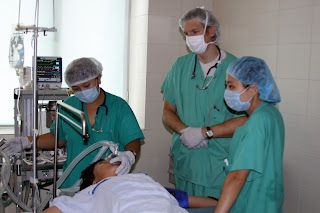 |
| Door to OR#1 |
Operating in a different operating room is like competing on the visiting teams field. You’ve got to make a quick assessment of the lay of the land and then play your game. Things in the Mongolian OR’s were quirky but in general, I was pleasantly surprised by the resources we had available. When things weren't up to par, we had our own biotechnician, Danny, who made things work, like our very own personal "roadie."
There were three general surgery operating rooms in the hospital. OR #1 was the largest with two big windows and two big OR lights. Unfortunately, when we arrived, there was only one functioning light bulb between those two large panels. Before our first cases, they found functioning bulbs for one light but one big light remained dark for our entire visit. The big windows helped in the daytime as the regular room lights were also missing bulbs. We relied on a back-up generator one day in Choibalsan and saw no interruption in power to the anesthesia machine, lights, or laparoscopic equipment in the room. We had a complete laparoscopic tower though the regulator on the CO2 tank was faulty and created a constant cricket-like chirp for two whole days of operating. Suction was also available but shared between the three general surgery operating rooms, the surgery ward, and the ICU. OR#1 accommodated a c-arm for intra-operative x-ray. This machine was 10-15 years old and required some work after our first series of cholangiograms provided a near white out image with the faintest hint of the biliary tree. Once it was adjusted, we had interpretable images.
 |
No Bulbs in those lights. Eventually, we got the small one working.
Danny is checking out the lap tower. |
 |
| The anesthesia machine in OR#1 |
 |
| Big light, no bulbs. |
The second general surgery room was smaller than my closet (I have a BIG closet but this room was still small) It fit the bed, anesthesia machine, bovie, and was filled when we brought in a laparoscopic tower and a back table of instruments. Lighting was again an issue and this room really only had one window. There was a small pass through to OR #1 which made it a good vantage point to spy into the action in the other room
 |
| Tight quarters in OR#2 |
The third room was about as big as OR #1, located on the opposite side of the hospital and was reserved for emergencies or infected cases. The anesthesia machine in OR#3 was not the most reliable.
Striking contrast to my new “home field” in Denver – with the state of the art Storz HD flat panels, fully integrated teleconferencing, video, audio, LED lights, even an integrated iPod dock . . . we are fortunate. But the stadium doesn’t make the team. Sometimes, I think we forget that.
 |
| RMHC OR#1 |






1 comment:
YEAH team!
Post a Comment